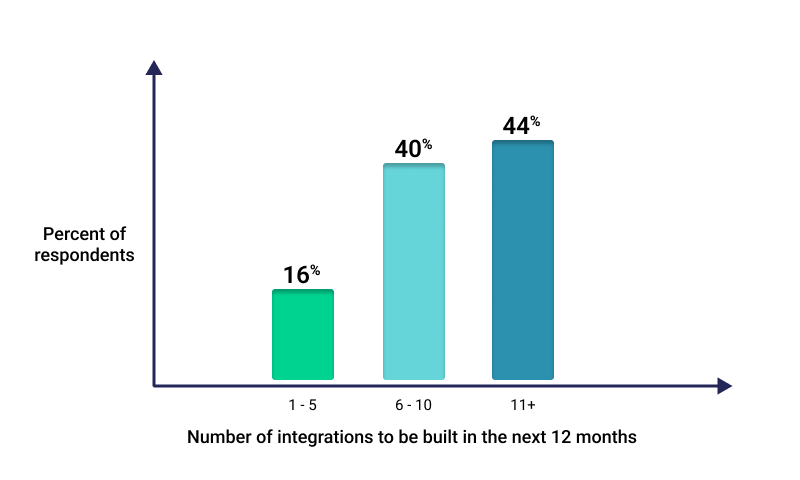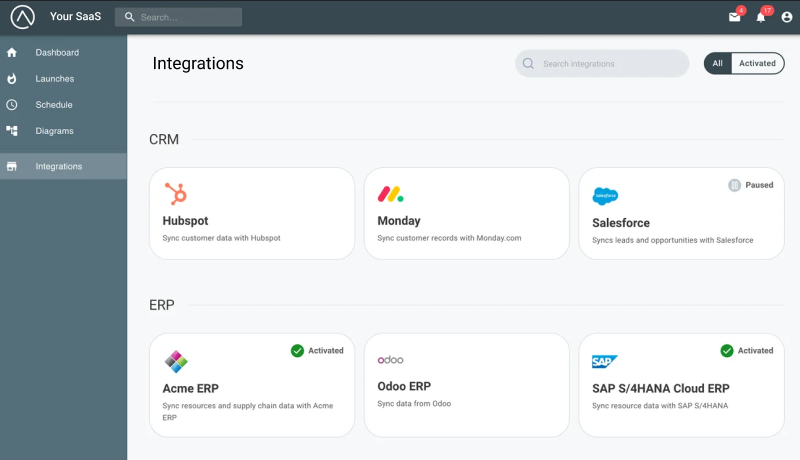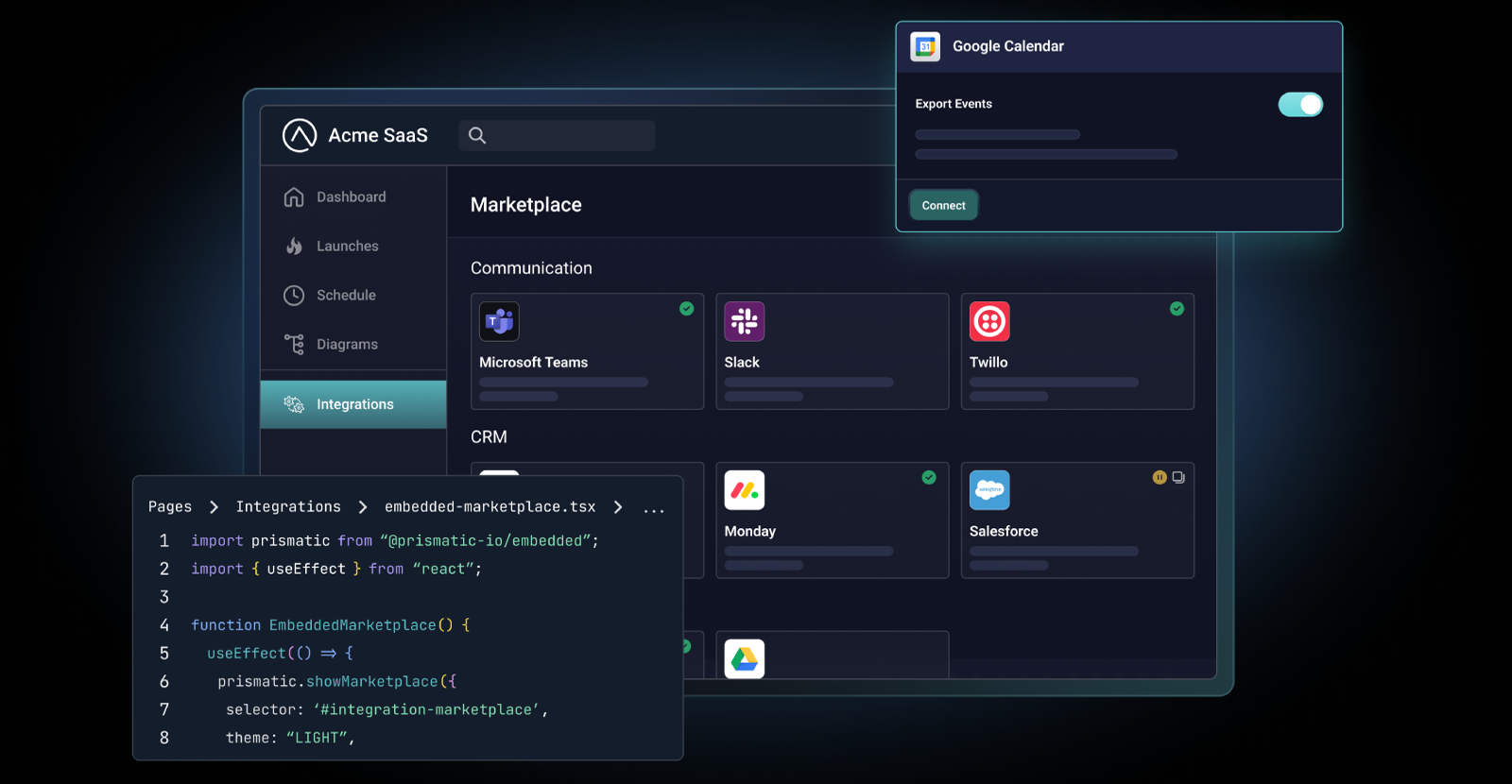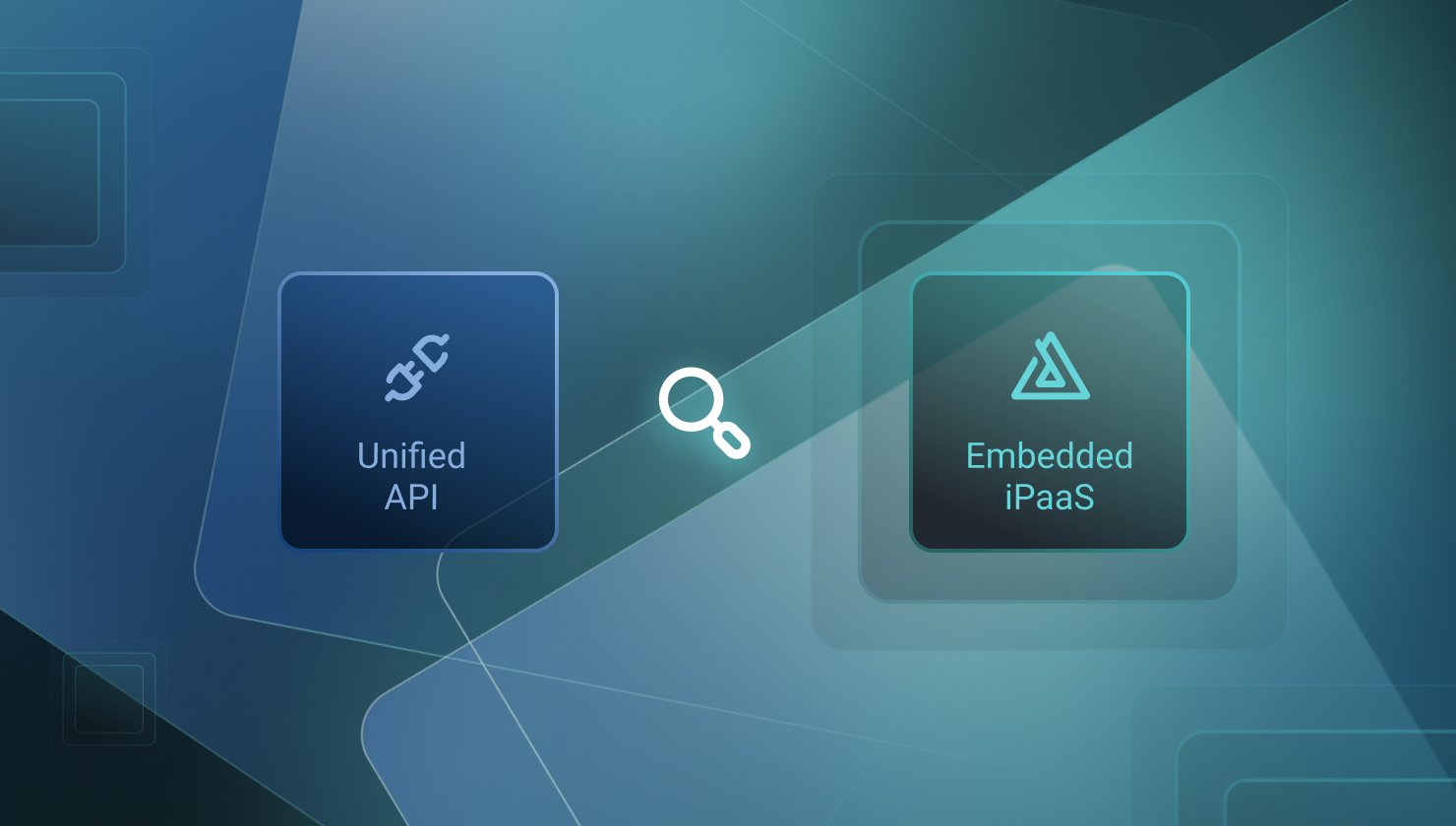An embedded iPaaS is a set of tools that enables a SaaS company to quickly build integrations connecting its product to the other apps its customers use and deliver those integrations as an integral part of its product.
It is embedded because it includes an integration marketplace, integration designer, and workflow builder that SaaS teams can white-label and embed in their product to create a self-activated, in-app integration experience for end users. This solution is also sometimes referred to as a white-label iPaaS.
Who needs embedded iPaaS?
Any B2B SaaS company that provides integrations for its customers can use an embedded iPaaS, making it essential for companies in every industrhy.
In addition, product, engineering, and support teams all benefit from the efficiencies of an embedded iPaaS.
Devs, for example, can save time by not having to build, deploy, and support integration infrastructure. Based on data from our customers (SaaS companies), 44% of them plan to build more than 10 integrations within the coming year, with some planning to build as many as 75 integrations in that time.
Once they've built these integrations, each of these companies can then deploy a single integration to any number of different customers, without needing to create unique integrations per customer. This speed of development and deployment is unthinkable for SaaS teams building integrations the traditional way. That approach often requires months of development per integration before they are customized and uniquely deployed and supported for each customer.

With an embedded iPaaS, support can also resolve many issues without engineering by using the platform-provided monitoring and troubleshooting tools.
Embedded iPaaS vs enterprise iPaaS
Embedded iPaaS and enterprise iPaaS sound similar but have different roles in creating and managing integrations.
An enterprise iPaaS is a general-purpose platform used by businesses to create integrations for internal use.
An embedded iPaaS is a purpose-built platform software companies use to create native product integrations for their customers.
For a comparison of these platforms, check out our post on embedded iPaaS vs enterprise iPaaS.
Unified API vs embedded iPaaS
SaaS teams often wonder which tool is the best to connect their SaaS product with their customers' other apps: a unified API or an embedded iPaaS.
A unified API connects multiple APIs in a common software category, like HRIS, to one API. This API abstracts the complexity of connecting to many systems into a single set of rules for one API, simplifying the process of building integrations with those systems.
An embedded iPaaS is a purpose-built platform SaaS companies use to create native product integrations between their product and any other app their customers use.
Depending on a B2B SaaS company's particular needs, it may make sense to provide customer integrations using a unified API, an embedded iPaaS, or a combination of both platforms.
For a comparison of these tools, check out our post on unified API vs embedded iPaaS.
Embedded iPaaS benefits
Embedded iPaaS provides B2B software companies with an efficient, cost-effective, and scalable strategy for customer integrations. Here are the benefits you could realize with an embedded iPaaS.
Reduce engineering effort
Building and managing integrations and integration infrastructure in-house takes much dev time and resources. Using an embedded iPaaS significantly reduces that burden.
Raven Industries reduced dev time per integration by 80% after implementing Prismatic. Read Raven's full story.
To see how much our embedded iPaaS might save you, we've embedded a simplified version of our ROI calculator. Enter your numbers in the fields below to estimate potential savings from using Prismatic for integration development.
To work with more variables and view underlying assumptions for these ROI calculations, use the more power version of our ROI calculator.
Productize your integrations
Too often, teams treat SaaS integrations as services, built as one-offs to meet a single customer's needs. Not only does this waste time and create maintenance headaches, but the results often feel like unpolished afterthoughts bolted on to the core product.
Prior to working with Prismatic, many of our customers had built several integrations. In many cases, they did this the traditional way – custom code and a lot of time. But that approach is not sustainable.
In contrast, an embedded iPaaS provides everything you need to productize your integrations and deliver them as a first-class part of your product offering.
Meet customer and market needs
Embedded iPaaS speeds up integration delivery by allowing non-devs to build integrations without waiting for dev resources. Devs can also write code for integrations without building and maintaining deployment infrastructure.
Teams are free to rapidly create needed integrations instead of waiting on an engineering backlog. Teams can quickly deliver a POC, say yes to a prospect's request, reach a new market segment, or meet growing customer needs.
Streamline customer onboarding
Integrations can also be a major source of risk and delay in customer onboarding. New customers' integration needs often get stuck in a dev backlog. When they eventually become high priority, there's often poor communication between customers and internal teams about requirements.
An embedded iPaaS enables the quick delivery of new customers' integrations as part of onboarding. Customer-facing teams can rapidly test, deploy, and iterate to ensure these new integrations work as customers expect.
Improve integration support
Many teams lack the tools to provide essential support for their customers' integrations. As a result, customers are often the first to know when an integration fails. And support staff struggle to quickly determine what went wrong, as they must often rely on devs to access logs or other info.
"Our customers now have an integration marketplace where they can connect and configure their integrations themselves which has reduced time and mistakes for our internal support teams."
An embedded iPaaS provides customer-facing teams a complete integration management environment with logging, monitoring, and alerting tools. This allows them to provide proactive integration support to efficiently examine and resolve integration problems.
Embedded iPaaS features

An embedded iPaaS includes:
- A low-code integration designer that empowers your non-devs to build productized integrations to be configured and deployed to multiple customers.
- A code-native integration building experience that enables your devs to use their favorite IDEs to code productized integrations to be configured and deployed to multiple customers.
- A library of built-in components of reduces your team’s work by providing connectivity to common SaaS apps and standard logic functions without writing any code.
- An integration marketplace that provides a self-activated, in-app integration experience for your customers when embedded and white-labelled in your product.
- An embedded workflow builder that enables your customers to build custom workflows between your B2B SaaS product and the customers' other apps.
- Configuration and deployment tools that enable your onboarding team to configure and deploy customers’ integrations without engineering involvement.
- Monitoring and management tools that enable your support team to monitor, and troubleshoot customers' integrations without engineering involvement.
- Customer self-serve support tools that empower your customers to configure, activate, monitor, and troubleshoot their integrations without support or engineering involvement.
Finally, all of this is built on top of a cloud-native infrastructure that runs the integrations and handles scaling, security, and compliance.
How to choose an embedded iPaaS
When choosing an embedded iPaaS, you'll want to answer a number of questions. These questions can be divided into the following categories: features, people, and process.
We just listed high-level features of an embedded iPaaS above. It is possible that you don't need all those, but you'll want to confirm that the embedded iPaaS you are choosing has all the high-level features you need – as well as low-level ones like built-in auth, integration versioning, or automatic retry.
"[Prismatic] is laid out in a clear and concise manner, but has a lot of really cool features and flexibility (like sharing endpoints between all users or making them super granular with per-user per-flow URLs), inline code blocks for writing small bits of logic quickly, provisioning triggers for handling integration deployment logic, pre-processing logic to route calls to specific users/flows, and the ability to dynamically reference deeply-nested fields from previous steps."
When choosing an embedded iPaaS, you need to know your expectations for the vendor, as well as how your devs (and non-devs) are planning to use the platform. Will the vendor be around for the long-haul? Will your non-devs build integrations, or is that something that will stay with your devs? Does the platform allow your devs to write whatever code your integrations need, or is that something only the vendor can do?
Finally, the process. You'll need to make sure you have the right people to dig into the embedded iPaaS via a demo and proof-of-concept and ensure that it can handle all your integration requirements, including edge cases and future needs.
For much more help with choosing an embedded iPaaS, check out our post on how to choose an embedded iPaaS.
How to scale your integration strategy with embedded iPaaS
You may have dozens of customers today, but you might have hundreds or thousands tomorrow. And, based on trends, each customer will use more apps over time. So you'll need to create even more integrations to keep pace.

An embedded iPaaS is the ideal tool to help you scale everything you need, including development, deployment, support, and infrastructure.
- Development scales as you can use the low-code designer and API connectors to build integrations with little code, and robust dev tools when you need to write entire integrations in your favorite IDE.
- Deployment scales as you list all your integrations in the embedded marketplace and allow customers to search, activate, and troubleshoot them. Use customer-specific configuration options to deploy a single integration to dozens or hundreds of customers efficiently.
- Support scales as you allow non-devs to handle more of the up-front issues and keep the devs for the truly difficult tickets. In addition, your customers have access to logs and monitoring data for their integrations, allowing them to address issues before they come to your attention.
- Infrastructure scales to match the integration load, all without you needing to do a thing. Quiet times or busy times, the infrastructure handles whatever load it needs to. Period.
For much more detail on scaling your integration strategy, check out our post on how to scale integrations.
Questions about embedded iPaaS
What is the best embedded iPaaS?
The best embedded iPaaS is the one that fulfills your B2B SaaS integration needs now and in the future. We recommend keeping the following questions in mind as you determine the embedded iPaaS that's best for you:
- Does the vendor focus on embedded iPaaS?
- Does the tool fit nicely with your existing development ecosystem?
- Can devs and non-devs create the specific integrations your customers need?
- Does the tool enable you to deploy and manage integrations at scale?
- Does the platform give your customers a great user experience?
For more details on these questions and comparison data for top embedded iPaaS systems, check out our post on the best embedded iPaaS.
Now that you know
An embedded iPaaS can be a game-changer for your team when it comes to figuring out how to move forward with a workable, sustainable B2B SaaS integration strategy.
Other tools can help with integrations, but the embedded iPaaS is the only one that is uniquely suited to build all the integrations you need between your SaaS product and your customers' other apps.
This platform allows you to maximize the integration potential of your dev and non-dev teams, without adding headcount.
Finding the right embedded iPaaS might take a bit of time and research, but the results are worth it.
Schedule a demo and we'll show you what an embedded iPaaS is and how it enables you to have a sustainable, scalable integration strategy.




